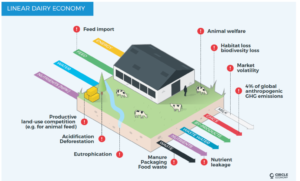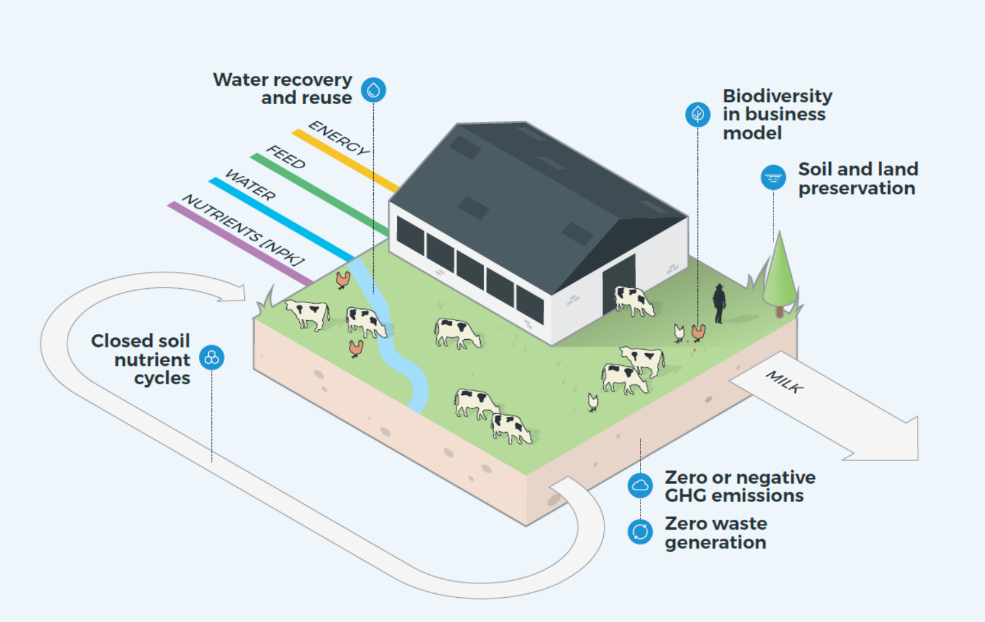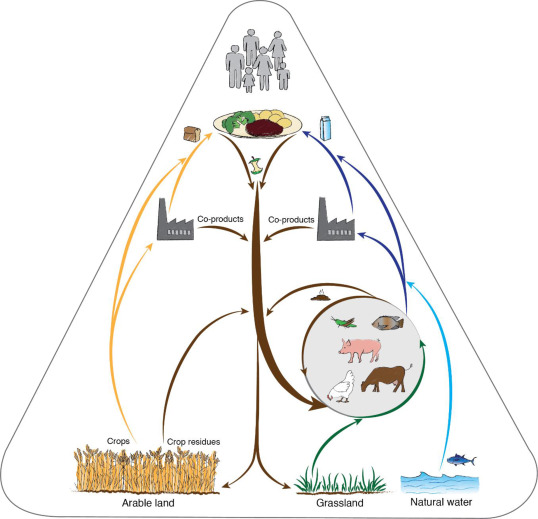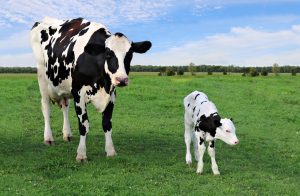Adolfo Alvarez Aranguiz
Since the green revolution, farmers have become more and more production-oriented and have been encouraged to maximize productivity through the increased use of farm inputs (i.e., fossil fuels, pesticides, mineral fertilizers, imported feed), improved plant and animal genetics, advanced machinery, and new technology. This has come at a cost of unintended harmful side effects on the landscape and the environment, which have become unacceptable to societies.
The current global food system has an enormous environmental impact. It is responsible for about a quarter of all greenhouse gases released by human activity, drives deforestation and loss of biodiversity, pollutes fresh and marine waters, and takes up 40% of the world’s ice and desert-free land (Poore and Nemecek, 2018).
We all know that the key challenge in the coming decades will be to produce enough safe and nutritious food for future populations without running out of resources or destroying Earth’s ecosystems –in other words, without exhausting the biological and physical resources of the planet.
Dairy production is not an exception within the global food system chain, and as all other components, needs to affront new challenges to assure “Food and Resource Security” for future generations.
New challenges for dairy production
The world dairy sector faces new challenges ahead that must be taken into account in the development and adjustment of the dairy production systems.
| Challenges of the dairy sector | Challenges of the dairy farmers |
|---|---|
|
|
This situation arises from the 4-5% annual increment in the world’s demand for dairy products, but also with unpredictable changes in consumers and market preferences, a situation that puts the dairy producer in an unclear situation for medium to long-time strategies, such as genetics or investments.
Background
The current production systems developed in parallel with the so-called “Green Revolution” during the 60s and 70s have clearly demonstrated their inefficiency with respect to food security and resource security. After 50 years, hunger is still a big problem around the world while resources keep diminished rapidly.
Agricultural/livestock systems, including milk production systems, developed during those years have been following a linear production system (Figure 1), based purely on an economic analysis and short-term results, where biological factors have taken a secondary role. These systems have been characterized by a high use of external inputs (fertilizer, feed, energy…) in order to maximize production (milk, meat, grain,…). In the particulate case of dairy farms:
Inputs (e.g., feed, supplements, fertilizers, insecticides, herbicides, energy, medications, hormones,…) have been used with the objective of increasing milk production, while aspects such as the environment, manure management, nutrients leakage, animal fertility…, have been considered secondary.

Figure 1. Dairy farm linear production system
Today, these linear systems, adjusted to the production conditions of the different regions, face very varied situations, with very specific challenges to overcome, and with their own characteristics for each country or region. This is the case of Europe and the USA with environmental and animal welfare problems, together with low animal fertility.
South America where the agriculture displaces animal production to marginal areas with the subsequent soil degradation, deforestation and drop in the water table level. Asia facing problems related with feed production and supply, together with the environment, and land availability and productivity.
New Zealand with high stocking rates, and a milk ono-production system; or Africa with high degraded lands and low productivity. Greenhouse gas emissions and water quality are common problems in most regions.
Future
The concept of circularity originates from industrial ecology (Jurgilevich et al., 2016), which aims to reduce resource consumption and emissions to the environment by closing the loop of materials and substances. Under this paradigm, losses of materials and substances should be prevented, and these should instead be recovered for reuse, remanufacturing and recycling.
In line with these principles, moving towards a circular food system implies searching for practices and technology that minimize the input of finite resources, encouraging the use of regenerative ones, prevent the leakage of natural resources (e.g. carbon (C), nitrogen (N), phosphorus (P), water) from the food system, and stimulating the reuse and recycling of inevitable resource losses in a way that adds the highest possible value to the food system (Jurgilevich et al., 2016).
The suggested solution, that is already underway in many regions of the world, is basically, the return to productive systems similar to those used by our grandparents, adding new technologies and knowledge and, of course, aiming at higher production, sustainability, profitability and simultaneously considered social aspects, economics and environment, what we call “circular production system” (figure 2).
What is sought with these new circular production systems is a balance between inputs and outputs, (i) where attempts are made to reduce external inputs to the farm with an increase in efficiency and control of final products, and (ii) where there are no longer single products (milk, grain …), but a set of them, which to some extent are revalued and recirculated within the system itself.
Animal production plays a key role in the circular system, especially in ruminants due their capacity to convert high fiber products (low nutritional value for the growing human population) in a high nutrient feed, like milk or meat, and manure that can contribute to the return of nutrients to the soil.
Rotation of annual crops with perennials, or animal production with agriculture, need to be considered as another important tool for resource maintenance.

Figure 2. Dairy farm CIRCULAR production system
These dairy circular systems are at the same time integrated and play an important role in the whole economic system due the high nutrition value of milk for humans, especially children.
During the process of adaptation to or development of a circular system, the particular circumstances, agro-ecological, social, and economics of the country, region or farm always need be considered. As extreme examples, we could mention Africa, where food security is a priority, and where the circular systems to be developed need to be based on a sustainable intensification over time.
Also, where the supply of a high nutritional value product, such as milk, can be ensured through the development of a production system focused in the conservation of natural resources, mainly soil and water, for future generations.
Dairy farms in Europe or in the USA are at the other extreme, where the priority is environment and resource security (air, soil and water), and where food security (hunger) is replaced by the so-called nutritional security (nutritional components of food, to avoid obesity and other “rich-countries” diseases).
These priorities lead to the European/USA milk production systems, which are based on smart control systems, with application of new technologies mainly in relation to energy, animal feeding, emissions control, water quality and recycling, and animal welfare.
Summary
The circular dairy production systems will play a key role in the future of the so-called circular economy, mainly in relation to food security and resource security (figure 3).

Figure 3. Circular economy
In order to attain a truly circular global dairy sector, further work is needed. Pathways should be broadened to cover (i) developing and emerging economy contexts, (ii) extensive grazing systems with large herds on large land areas, and (iii) highly intensive systems with up to thousands of cows per farm and water stressed areas, among other areas.
Research is also needed to deepen the analysis of different pathways, comparing their economic, social and environmental performance, identifying strategic levers that can be activated to make circular dairy farming competitive, and ensuring their feasibility and relevance at regional and local scales around the world.
It is also evident that practical steps must be taken to ensure farmers are the drivers, given that any successful transition will rely on actionable, collaborative approaches taken on the ground, while subsequent steps will require the contribution of best practitioners and collaboration with the broader value chain.
About the author
Adolfo Alvarez Aranguiz is Researcher at Wageningen University & Research, Netherland. His fields of expertise are ruminant nutrition, dairy farming, fodder production, feed formulation, grassing management, and tropical livestock.
Reference
Poore, J. and Nemecek,T., 2018. Reducing food’s environmental impacts through producers and consumers. Science 360: 987-992.
Jurgilevich, A., Birge, T., Kentala-Lehtonen, J., Korhonen-Kurki, K., Pietikäinen, J., Saikku, L. and Schösler, H., 2016. Transition towards circular economy in the food system. Sustainability 8(1): 69.
© 2020 Dairy Knowledge Center. All Rights Reserved.











